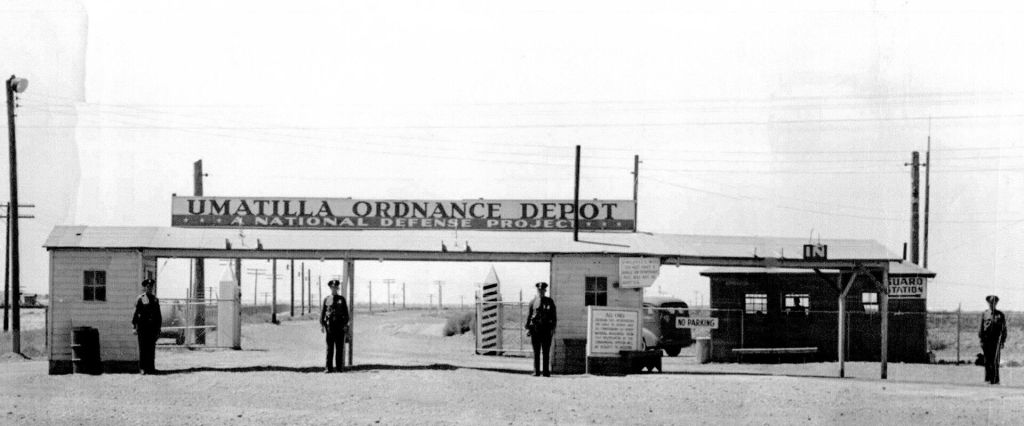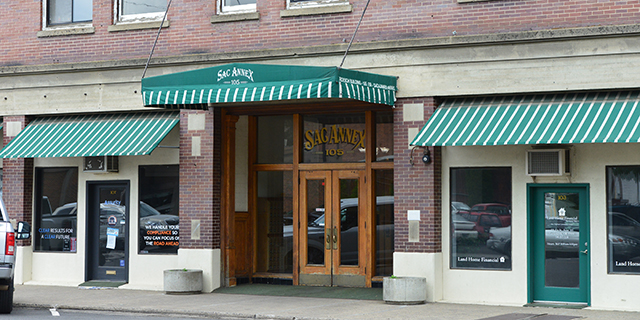Columbia Development Authority director to sign paperwork transferring depot land from Army
Published 3:00 pm Thursday, September 29, 2022

- Guards stand at the entrance to the Umatilla Ordnance Depot in this undated photo from the Oregon Military Department. The depot originally opened in 1941 as the Umatilla Army Ordnance Depot, used to store munitions and conduct supply operations. In 1962, the installation began storing and maintaining chemical munitions. In 2011, the disposal of all chemical agents at the site was complete and in 2012, the U.S. Army officially closed the installation.
BOARDMAN — The Columbia Development Authority at long last is about to become the owner of the former Umatilla Chemical Depot.
CDA Executive Director Greg Smith wanted one more day to again review the memorandum of understanding that transfers ownership of the land before signing it Thursday, Sept. 29.
“After nearly 30 years of conversations and negotiations, the board authorized me to sign the document transferring depot land from the U.S. Army to the CDA,” he said. “I’m going to take one more day to read the MoA one last time, in addition to the thousands of times before. It’s a momentous event.”
CDA’s board of directors met on Sept. 27.
“The board is to be commended for its diligence and leadership,” Smith said. “I sign on their behalf. In the near future, CDA will hold a celebratory signing with board Chair Jim Doherty.”
The CDA’s board consists of Doherty, Morrow County commissioner; Vice Chairman Kim Puzey, general manager of the Port of Umatilla; Lisa Mittelsdorf, executive director of the Port of Morrow; Don Sampson, executive director of the Confederated Tribes of the Umatilla Indian Reservation; and John Shafer, Umatilla County commissioner. The depot straddles the border of Umatilla and Morrow counties west of Hermiston.
“The Army still has to sign,” Shafer said. “It needs to send original documents by mail, so that could take two or three weeks. But then the transfer will be complete. This has been coming for quite some time.”
Smith noted three years of work by former board members, such as Gary Neal, former Port of Morrow general manager; state Sen. Bill Hansell, R-Athena, a former Umatilla County commissioner; and the late Terry Tallman, past Morrow County judge and Boardman mayor.
Smith said the CDA would remain intact to benefit economic development for seven years after the final transfer. It can sell and lease land but has to reinvest funds received back into the CDA during that period.
“I would like to add one last thought,” he concluded. “Now the hard work really begins. We need to be strategic and thoughtful as to how we use the property for future generations.”
Oregon to rename depotThe Columbia Development Authority is to receive nearly 10,000 acres from the former ordnance depot. The Army had previously transferred about 7,500 acres to the Oregon Military Department, which operates a training facility there.
Smith signing the memorandum Sept. 29 coincides with the Oregon Military Department holding a ceremony to rename the Umatilla Chemical Depot as the Raymond F. Rees Training Center in honor of retired Maj. Gen. Raymond F. Rees, of Helix, four times former Oregon National Guard adjutant general.
Rees also held various high-level positions in the National Guard Bureau and Pentagon during his military service and as a civilian. The Raymond F. Rees Training Center will be the home of the 249th Regional Training Institute, providing a premiere joint and interagency training facility.
Land transfer repeatedly delayed over the yearsThe depot was added to the Base Realignment and Closure Act hit list in 1988 and again in 2005. U.S. endorsement of the Chemical Weapons Convention treaty prompted construction of plants across the country to destroy America’s stockpile. Umatilla Chemical Agent Disposal Facility was constructed from 1997 to 2001. Demilitarization operations began in September 2004 and ended in October 2011.
The depot’s community-based Local Redevelopment Authority was officially recognized by BRAC in 2009. The demolition of UMCDF after the completion of demilitarization set the stage for returning depot land to public use. The Army held a deactivation ceremony at the depot on July 17, 2012, marking the end of the installation’s mission of safely storing conventional and chemical munitions.
The Local Redevelopment Authority became the Columbia Development Authority in 2014. Its five members are the ports of Umatilla and Morrow, Umatilla and Morrow counties and the Confederated Tribes of the Umatilla Indian Reservation.
Transfer of the remaining depot land from the Army to the Columbia Development Authority was initially expected to happen in 2018, then late 2019 or early 2020. A variety of delays, including from COVID-19, set the date back to October 2022.
Umatilla Chemical Depot history
The U.S Army selected its Ordnance Depot’s location in 1940 because it was vast, had a low population and was located near the Columbia River, railroad tracks and a major highway system. The 17,000 plus acres were owned by local people and the federal Interior Department. Construction of the ordnance depot began in January 1941. At its peak, more than 7,000 people worked there.
Weapons storage igloos number 1,001. They were camouflaged from the air, blending into the natural habitats of the landscape. Igloos come in two sizes. Their ends and sides are ten inches of steel-reinforced concrete, covered with two feet of dirt. On September 1941, workers built 24 igloos in one day.
Tragedy struck on March 21, 1944. Crew had been loading 500-pound bombs into an igloo when it exploded, with 264 bombs inside. Five male civilian workers and one woman died in the blast, which was heard 30 miles away and broke windows up to 20 miles distant. The exact cause of the explosion was never determined. Igloo design and construction worked. The explosion went up rather than out, so surrounding igloos were not damaged.
In 1962, the ordnance depot’s role changed. Chemical weapons were added to the conventional munitions it had stored since 1941. Its name was changed accordingly.









